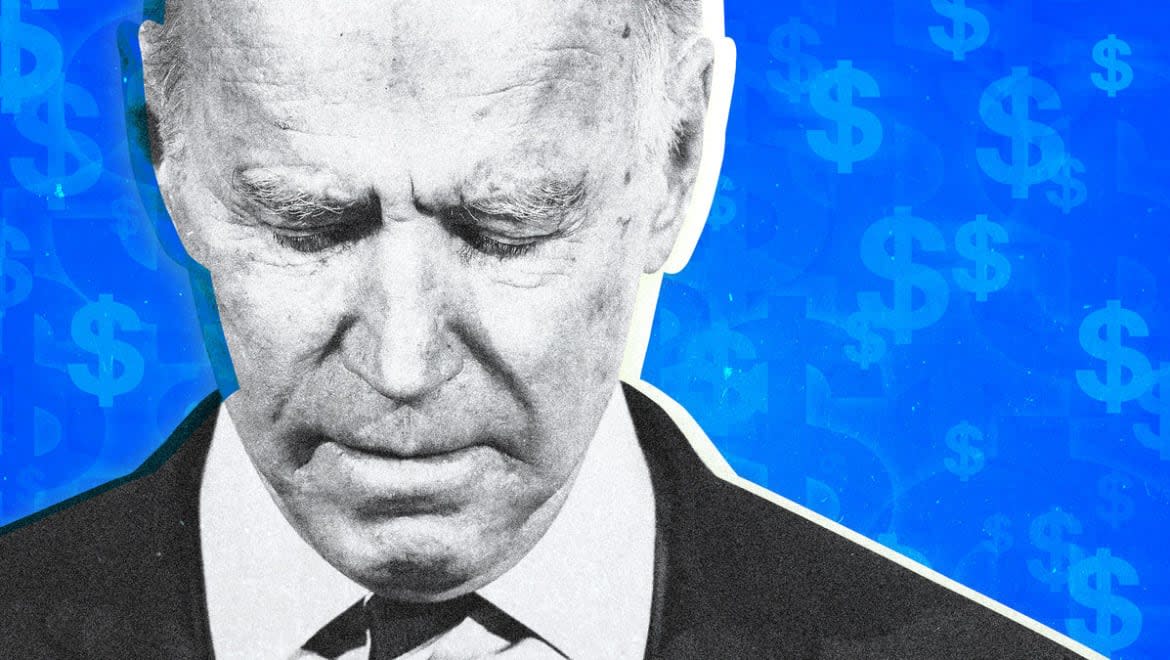Bidenomics Looks Like a Ticking Time Bomb for Democrats (and the Economy)

- Oops!Something went wrong.Please try again later.
- Oops!Something went wrong.Please try again later.
Ever since Joe Biden floated his $1.9 trillion COVID-relief bill, worrywarts like yours truly have been warning about the possibility of inflation.
In case you weren’t alive in the 1970s, inflation erodes the value of money. Simply put, your paycheck is worth less today than it was last week or last month. This demoralizing and frustrating decline in purchasing power can have the psychological effect of causing consumers to spend money quickly, for fear that prices will rise. There is also increased pressure on welfare and wages to keep pace with the rising cost of living. Once this cycle gets going, it’s hard to unwind. After the 1970s, this became a much-feared cautionary tale, but since it hasn’t been a big problem for four decades, there’s a sense that such concerns are overblown now that the internet, automation, the rise of income inequality, international trade, and a global market have somehow rendered it anachronistic—or that the Federal Reserve can quickly control inflation by hiking interest rates, with no discernible downside.
Here’s hoping inflation is no longer a threat, since if the old rules still apply there’s a real chance we’re overheating now.
Biden’s Reboot of That ’70s Show Looks Like a Disaster
For months, the cognoscenti scoffed at these concerns and advised us not to panic. In February, Fed Chairman Jerome Powell downplayed inflation concerns, telling the Senate Banking Committee that “we’ve averaged less than 2 percent inflation for more than the last 25 years.” As CNN’s John Harwood reported, when Larry Summers became one of the few prominent Democratic economists to sound the alarm in March, “Biden aides responded that, while they were monitoring inflation risks, the danger of spending too little to recover from the effects of the pandemic exceeded the risks of spending too much.” Meanwhile, Charles Evans, the president of the Federal Reserve Bank of Chicago, said, “This isn’t the ’70s. We’ve had trouble getting inflation up.”
Now the tone has changed—dramatically. Speaking with The Atlantic, Treasury Secretary Janet Yellen conceded, “It may be that interest rates will have to rise somewhat to make sure that our economy doesn’t overheat.” Inflation accelerated in April, jumping to 4.2 percent, the highest it’s been since 2008. A New York Times headline on Thursday boldly declared, “Inflation Is Here. What Now?” Meanwhile, the high cost of lumber threatens to drive up housing prices, and CNN Business reports, “Just about everything is getting more expensive in the United States as the stimulus-fueled economy rebounds and Americans are again spending on shopping, traveling and eating out.”
In the span of a few weeks, the messaging dial seems to have shifted, in effect, from “Spend away, since inflation doesn’t exist anymore,” to “This should just be temporary!” and “This was always to be expected as the economy reopened.” Meanwhile, Summers is now saying his “concerns about overheating have grown substantially over the last several months.”
If the old rules still apply, and it appears that they do, we are experiencing the classic economic situation where “too many dollars are chasing too few goods.” People who have been in COVID lockdown for a year now have Biden’s stimulus money—and it’s burning a hole in their pockets. What is more, Biden’s other policies could be hindering what many of us thought would be a quick recovery following the vaccine rollout. With that successful rollout comes increased consumer demand but not enough supply—or service workers—to meet it.
This may not be an accident. According to analysis by the U.S. Chamber of Commerce, the $300 weekly unemployment supplement (on top of what states already provide) “results in approximately one in four recipients taking home more in unemployment than they earned working.” On top of other negative externalities, this scarcity of workers could drive the cost of labor higher, resulting in rising prices being passed on to consumers. In other words, inflation.
In a healthy environment, a robust conservative movement would be presenting coherent arguments that push back against Bidenomics, and possibly cause Democrats and the American public to think twice about how government spending can overheat an economy. This might at least slow down the cycle or prevent the economy from spiraling out of control in some negative feedback loop. But conservatives have discredited themselves (thanks Trump!), which does a disservice both to America and to progressives, whose overly ambitious ideas now have no natural predators. Absent anything to mitigate or check their flawed priors or ideological tendencies, it’s off to the races.
Absent this awareness, Joe Biden, who hoped his big spending would make him the modern day FDR or LBJ, could instead become Jimmy Carter or Gerald Ford. Voters might find themselves wistfully recalling the halcyon days before COVID-19 wrecked “the greatest economy that we’ve had in our history.” If you’re looking for a nightmare scenario where Donald Trump is miraculously (re)elected in 2024, this could be it.
Get our top stories in your inbox every day. Sign up now!
Daily Beast Membership: Beast Inside goes deeper on the stories that matter to you. Learn more.

